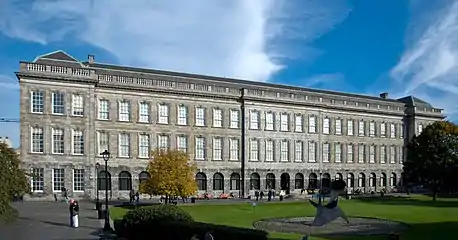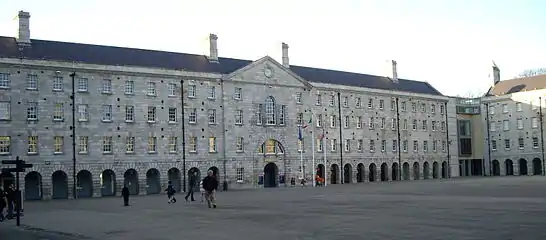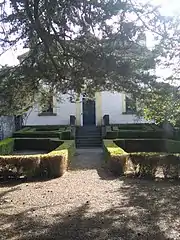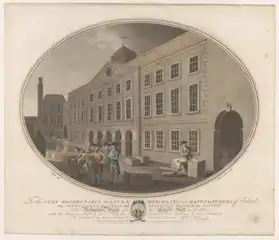Thomas Burgh (1670–1730)
Colonel Thomas de Burgh (English: /dˈbɜːr/; d’-BER; 1670 – 18 December 1730), always named in his lifetime as Thomas Burgh, was an Anglo-Irish military engineer, architect, and Member of the Parliament of Ireland who served as Surveyor General of Ireland (1700–1730) and designed a number of the large public buildings of Dublin including the old Custom House (1704–6), Trinity College Library (1712–33), Dr Steevens' Hospital (1719), the Linen Hall (1722), and the Royal Barracks (1701 onwards).
Thomas de Burgh | |
|---|---|
 Old Library Building, Trinity College, Dublin | |
| Surveyor General of Ireland | |
| In office 1700–1730 | |
| Preceded by | William Robinson William Molyneux |
| Succeeded by | Edward Lovett Pearce |
| Lieutenant-General of the Ordnance | |
| In office 1705–1713 | |
| Preceded by | Chidley Coote |
| Succeeded by | Richard Molesworth |
| Member of Parliament for Naas | |
| In office 1713–1730 | |
| Preceded by | Alexander Gradon James Barry |
| Succeeded by | Thomas Burgh John Bourke |
| Personal details | |
| Born | Thomas Burgh 1670 |
| Died | 18 December 1730 (aged 59–60) |
| Nationality | British |
| Spouse |
Mary Smyth (m. 1700) |
| Children | 9, including: Thomas Burgh Richard Burgh |
| Parent(s) | Rt Rev Ulysses Burgh Mary Kingsmill |
| Relatives | Ulysses Burgh, 2nd Baron Downes (grandson) |
| Alma mater | Trinity College, Dublin |
| Military career | |
| Allegiance | |
| Service/ | |
| Years of service | 1688–1730 |
| Rank |
|
| Unit | Lord Lovelace's Regiment of Foot |
| Commands held |
|
| Battles/wars |
|
Early life
Thomas Burgh was the son of Rt Rev Ulysses Burgh (d. 1692) of Drumkeen, County Limerick, who was Dean of Emly and later Bishop of Ardagh. His mother was Mary, daughter of William Kingsmill of Ballibeg, County Cork. His brothers, Richard Burgh of Dromkeen and Drumrusk and William Burgh of Bert House, Athy, were both Members of the Irish Parliament.
Thomas was educated at Delany's school in Dublin, and Trinity College, Dublin, where he matriculated on 22 November 1685 and left without taking a degree.[1] Prior to the outbreak of the 1688 wars he is likely to have left Ireland for London with his father. He returned to Ireland in the army of King William III, as a lieutenant in Lord Lovelace's Regiment of Foot, and served at the Siege of Limerick.[2] This may have been followed by a brief spell in the Irish Engineers from 1691. In any case, de Burgh was commissioned as a Captain in 1692 in the Royal Regiment of Foot. In this capacity, he served in the Low Countries at the Battles of Steenkerke (1692) and Landen (1693), and as an engineer at the siege of Namur (1695). During this time, he absorbed the ideas of the Dutch engineer Menno van Coehoorn (1641–1740).[2] In 1697, he became Third Engineer on the Irish establishment.[3]
In 1700, Burgh replaced the Surveyor General of Ireland, William Robinson, and, one year later, also became Barracks Overseer in Ireland. Under his command, the building of barracks was expanded and the rebuilding of Dublin Castle (begun under Robinson) was completed. The Royal House at Chapelizod (County Dublin) and Chichester House in Dublin were repaired as well as numerous coastal fortifications.
As well as a Colonel of the Engineers (Lieutenant-Colonel, 11 April 1706), Burgh held a Captain's commission in Brasier's Regiment of Foot from 1707 to 1714.
Public life
In 1704, Burgh was admitted as a freeman of the City of Dublin in recognition of his work in enriching Dublin's architecture. He was later admitted to the Dublin Philosophical Society. He served as Member of Parliament for Naas from 1713 to 1730 and as a government minister. He was appointed High Sheriff of Kildare in 1712, Governor of the Royal Hospital Kilmainham in 1707 and served as a Trustee of Dr Steevens' Hospital from 1717 to 1730.
From 1705 to 1714, he was Lieutenant-General of the Ordnance for Ireland,[2] an appointment which (held with that of Surveyor General) made him the most influential officer in the Irish Board of Ordnance. In this role, he was responsible for overseeing the construction and renovation of all military buildings in Ireland as well as other public works. De Burgh had his commission successively renewed over the 27 years following his appointment as Surveyor General in 1700.
Architect
De Burgh was responsible for the design of several public buildings in Dublin:
- The Custom House (1704–6), (superseded by James Gandon's Custom House in 1791 further downriver)
- Trinity College Library (1712–33)
- Dr Steevens' Hospital (1719-33)
- Linen Hall (1722)
- Royal Barracks (1701 onwards)
- The Armoury, Dublin Castle
- Chapelizod House
- St. Luke's Church, Dublin
- Collegiate School Celbridge
- Ballyburley House
Burgh was also responsible for the building of several churches, including St Mary's Church in Dublin 1 (now a Popular Café Bar & Restaurant) and St Werburgh's (1715). He is known to have built a number of private houses, most of which no longer exist, including the O'Brien family house at Dromoland, County Clare, in about 1719.
His own country house at Oldtown near Naas, County Kildare, was the only building into which he introduced Palladian ideas. He acquired the land in 1696 and the house was built thirteen years later. His architectural style was otherwise "restrained" and notable mainly for massing on different planes, using a central five-bay front crowned by a large pediment, and arcading on the ground floor. Oldtown remained the family home, although a fire destroyed the original main house and a wing in the 1950s.[4] He also designed Kildrought House in nearby Celbridge.
He worked on several engineering projects, including improvements to Dublin Harbour and the proposed Newry Canal, although this was not built until after his death.[2] Burgh published a pamphlet entitled "A method to determine the areas of right-lined figures universally, very useful for ascertaining the contents of any survey" (Dublin, 1724).
In 1728 Burgh lost the commission to build the new Parliament House in Dublin to Edward Lovett Pearce (1699–1733), who succeeded de Burgh as Surveyor General on his death, after an illness, in 1730.[2]
Family
Burgh was married to Mary, a daughter of Rt Rev William Smyth, Bishop of Kilmore, on 10 July 1700. They had five sons and four daughters. His townhouse was in Dawson Street (now rebuilt) and his country estate was at Oldtown in County Kildare. He also owned lucrative collieries in County Antrim.
Their children were:[5]
- Thomas Burgh (1707–1759), succeeded his father as MP for Naas
- Colonel Theobald Burgh (b. 1709)
- Ulysses Burgh (died 1742)
- Rev John Burgh (died 1767), vicar of Donaghmore, County Monaghan
- Richard Burgh (died 1762), a barrister of Drumkeen, County Limerick, succeeded his brother as MP for Naas; he left much of his property to his sister Elizabeth's son Walter Hussey, who took the name Walter Hussey Burgh
- Mary, who married a cousin, also named Thomas Burgh
- Dorothea, who married as his second wife Rt Hon Anthony Foster (1705–1779), Chief Baron of the Irish Exchequer in 1749
- Catherine (died 1797), who married Rev John Alcock, Dean of Ferns
- Elizabeth (1705–1757), who married Ignatius Hussey, and was mother of the Rt Hon Walter Hussey Burgh MP PC (1742–1783), Chief Baron of the Irish Exchequer, a leading member of the Irish Patriot Party and a noted orator.
Surname
In 1848, Thomas Burgh's grandson Ulysses Burgh, 2nd Baron Downes was allowed to change the family surname to "de Burgh" by Royal Licence.
See also
- House of Burgh, an Anglo-Norman and Hiberno-Norman dynasty founded in 1193
- de Burgh, surname
References
- Alumni Dublinenses: a register of the students, graduates, professors and provosts of Trinity College in the University of Dublin (1593–1860), George Dames Burtchaell/Thomas Ulick Sadleir p. 113: Dublin, Alex Thom and Co, 1935
- "Burgh, Thomas". Dictionary of Irish Architects 1720–1940. Irish Architectural Archive. Retrieved 21 July 2010.
- Bunbury, T (2004) The Landed Gentry & Aristocracy of Co. Kildare. Irish Family Names, Dublin
- Rolf Loeber, "Burgh, Thomas (1670–1730)", Oxford Dictionary of National Biography, online edn, Oxford University Press, Sept 2004
- Burke, E. (1912) Landed Gentry of Ireland, London
External links
- List of works by Thomas de Burgh, Dictionary of Irish Architects 1720–1940
Gallery

 Main Square of the (Royal) Collins Barracks, Dublin
Main Square of the (Royal) Collins Barracks, Dublin

 Old Library Building, Trinity College, Dublin
Old Library Building, Trinity College, Dublin A view of the Linenhall, Dublin from around 1782 by the engraver Robert Pollard
A view of the Linenhall, Dublin from around 1782 by the engraver Robert Pollard